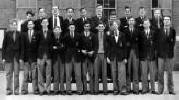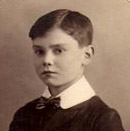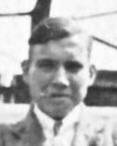|
- THE CHARLES
EDWARD SMITH
NARRATIVE - |
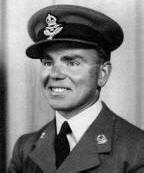 |
Hello!
This is the voice of C.E.S! You know – “Smithy”... “Old Smut” –
that mild little man you used to brush to one side as you raced
down the School corridor.
No?
Very well then. That mixture of Attila the Hun, Genghis Kahn and
the Ogre from the top of the beanstalk! Please yourselves!
There is no cause for alarm, as those who saw me at the memorial
service for Alan Murray on 21 March 2005 in Purley would
realise. You just have to kick aside my walking stick and I’ll
be at your mercy.
However, I will now endeavour to clear up some misconceptions that
still seem to persist.
I was born on 16 Nov 1912 at Gosport, Hampshire; the son of a Royal
Marine. As such I was able to start my early “learning curve” at
a very good school where the headmaster and the deputy head were
captains of Marines, |
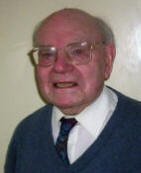 |
|
Flying Officer RAFVR,
Charles E. Smith. |
Charles Edward Smith,
March, 2005, aged 92 |
|
and the staff were
sergeants and corporals. I believe that it was during
this early schooling in the military education system
that I caught onto the idea that ORDERS WERE TO BE
OBEYED!!
Growing up in Portsmouth
Passing the “11 plus” enabled me to go to Gosport Grammar School. I
soon learnt that Hampshire IS the county for cricket! As a schoolboy, I used to attend Fratton Park (the home of
Portsmouth FC) on a Saturday afternoon to watch and cheer Pompey
to many a victory. Some years later, this was reflected in the
little sailor news cut-out that used to appear each Monday
morning on my classroom notice board – indicating if Pompey had
won, lost or drawn.
Together with five of my colleagues from King Alfred’s College of
Winchester (on advice from our Senior Tutor) we applied for
teaching posts to the Croydon Education Committee. All of us
were accepted and three of us remained with Croydon Education
for the whole of our teaching careers.
Was it lack of ambition or job satisfaction that we stayed for so
long? For me the latter.
It was in Croydon at my very first appointment during September
1934 to Ingram Road School, Thornton Heath, that I met Mr.
William Cracknell. It was to become a professional and family
association that lasted until his death in the year 2000.
The outbreak of war in 1939 meant the evacuation of the Ingram Road
School, to Brighton. At that time there was no schooling as such
and our role as teachers was to keep contact with our pupils
either in the local Park or on a beach! After the evacuation of
military servicemen from Dunkirk, we were relocated to a school
near West Byfleet. As well as my teaching duties I was also
recruited as a Fire Watcher and Air Raid Warden during Air
Raids.
It will undoubtedly be a real surprise to all who have known me
over the years, to learn that I failed my application for Active
Service because of incipient leg trouble discovered when I was
called up for military service with the RAF.
Joining JRCS at Tamworth Road
In 1941 I was instructed by my employers (Croydon Education
Committee), to return to Croydon and to join the staff at John
Ruskin Central School in Tamworth Road where, to my great
pleasure, I rediscovered Mr. William Cracknell already a
well-established member of staff.
In a reference given to me by Mr. McLeod in 1948, he writes “...
Mr. C. E. Smith joined my Staff primarily as an Instructor in
Physical Training... But I found that I had also gained a
class-master of the highest quality in Mathematics and Religious
Knowledge."
I have been everlastingly grateful for the wonderful good fortune
that led me to the appointment at John Ruskin.
The popular belief when I joined
the school - and it appears to be prevalent since - was that I
had been a Physical Training Instructor/PTI in the Royal Navy, a
belief that was completely unfounded! At no time have I ever
been in the Navy.
However, unbeknown to anyone at John Ruskin, Tamworth Road, I had
joined the RAF Volunteer Reserve with the rank of Pilot Officer
and subsequently as a Flying Officer.
During 1943-45 I served with three other officers at the 79th
Squadron ATC based at St Joseph’s College, Upper Norwood, as a
teacher of Basic Mathematics and Air Navigation and, with the
aid of large scale maps of the Eastern Approaches, the art of
Pathfinding by plotting Air Speed, Ground Speed and Wind Speed.
The Squadron had a regular Sunday morning Parade in the College
grounds each week. Little did I know that many years later. in
1980. I would be on the teaching staff at St. Josephs College in
Beulah Hill, Croydon.
On August 6 1945 I was at an RAF base near Weston-Super-Mare when I
heard a Tannoy announcement declaring that the Atom Bomb had
been dropped on Hiroshima; an event in history that will forever
be remembered. It did not just herald the ending of the war
against Japan; it was the beginning of a dangerous new era for
the world.
When I joined the staff of John Ruskin Central School in September
1942 as P.E. and maths teacher it was traditionally a soccer
playing school but with very few sports facilities. There was
only a small, hard surfaced playground between the building and
wall alongside the road outside. However, a short bus ride, or
more often than not a walk, would take us to the foot of Duppas
Hill where we had a football pitch and a small hutment with a
single changing room. At one end was a storage section for the
grounds man’s machinery and, at “our” end, a sink with a
cold-water tap.
Like most other things during the war, sporting equipment was
nearly impossible to purchase and very hard to obtain even from
the closest of contacts. A couple of soccer balls and a few
unmatched team shirts were all that we had to our name. (See
Peter Oxlade's 2nd X1 photo of 1943-44
below for a view of
the team shirts, socks of various colours, and the heavy-toed
football boots.)
There was a strong soccer tradition at Ruskin and within the
Schools’ Football League in the Borough of Croydon. I continued
what had clearly been the norm prior to 1939. After the war,
when John Ruskin became a Grammar school, it was felt by some
that rugby should become the recognised sport and that soccer
should be dropped. Many a debate took place on this subject and,
in the end, it was Mr. Lowe who, after listening to all the
arguments, decided that the school tradition of playing soccer
should be maintained.
I was very happy with the headmaster’s decision to continue the
school’s football tradition since 1920. It was now a question of
finding opponents available for inter-school matches.
Our intake at Ruskin was from boys who had passed the 11-plus in
Croydon Schools. Those who were less fortunate and did not pass
were educated in various other Senior Schools in the Borough of
Croydon, which meant that there was an immediate supply of
football playing opponents locally. Gradually, as travelling
became easier in that post war era, I was able to extend
fixtures to neighbouring locations in Sutton, Cheam, Epsom,
Woking, Guildford, Bromley and Upper Norwood.
It took years of patient building and expansion to successfully
produce the full cricket and football fixture lists that we had
until my retirement.
During my many years at John Ruskin, I served on the Croydon
Schools Cricket and Football Committees and the Surrey Schools
Committee. I travelled as an associate member of the English
schools cricket teams to grounds such as Old Trafford,
Edgbaston, St Helens, Swansea, the Oval and the home of Cricket
– Lords; and enjoyed every minute of it.
The Windmill - Tamworth Road to
Shirley Hills
In 1955 the school was moved from
Tamworth Road to a new, purpose-built school with a
“countryside” outlook in the Shirley Hills. This represented a
marked transformation for students and staff. At last, we had
space and a sensational outlook.
The building had well appointed classrooms, science and art rooms,
an assembly hall with a professional stage and a REAL gymnasium
for ME to teach in.
However, there was one criticism of the new site layout. The
kitchens and dining hall were adjacent to the main entrance of
the school and did nothing to enhance a positive first
impression for visitors.
I am sure that one of the things that pupils will remember is my
insistence that full respect would be given to all the furniture
and fittings in my care. When I left in 1978 the furniture was
left by me in pristine condition.
There was a generous playground on one side of the building and on
the other, beyond a preserved ancient Windmill, there was a
piece of ground available for sports opportunities. For the
first time in the school’s history we had all of this, together
with a playing field complete with a Pavilion located off Oaks
Road (a few hundred yards walk from the rear exit of the
school). This certainly represented a vast improvement on the
facilities previously enjoyed at Duppas Hill when the school was
in its Tamworth Road location.
As sports master, there were inevitably times when I was called to
the telephone (no extension lines or mobiles in those days) to
consult with other schools regarding the arrangement of sports
fixtures, etc. In view of this, it was agreed that I should be
based in Room 1, the nearest to the school office and its
telephone! One of the bonuses of being in Room 1 was that I had
an excellent daily view of the Windmill – so I feel I can truly
claim to be a very early “Friend of the J. R. Windmill!” Within
the windmill itself the ground floor space provided an adequate
area for the storage of cricket nets, practice hurdles and other
equipment associated with the sports function.
One other bonus for being in Shirley, as opposed to Tamworth Road,
was that during games periods I was able to arrange for a small
group of the Fifth and Sixth forms to use the tennis courts at
the Shirley Sports Club, and other sporting facilities readily
available in the local vicinity.
The nearby Shirley Hills provided us with a ready made natural
cross country jogging circuit. It did not take long to recognise
not only how decidedly better it was at Shirley, but also to be
aware of the miracles that both staff and students at Tamworth
Road had worked to achieve such high standard in both work and
sport in the conditions that existed there.
When I look back over the many years that I spent at John Ruskin, I
feel a warm glow of gladness and gratitude. To have worked with
so many excellent professional people for such a long period was
a great joy. I will remember the many of our students for the
high standards that they achieved in both academic and sporting
activities.
After 36 years at the school...
In 1977, I reached my retirement age with a mixture of
fulfillment
and sadness, tinged with disappointment that my leaving date
would be before a group of our students took their examinations.
Thus, it was with great delight that I received the news that
the Education Committee had agreed that I should stay on until
those exams had been completed.
With sadness in my heart, I said my fond farewells to colleagues
and students in the summer of 1978.
I consider that it was a real privilege to have had the opportunity
of teaching at John Ruskin, and I cherish my memories of that
rewarding and happy time. I am very grateful to all those people
who contributed towards it.
Like many others who reach the time when the daily tasks of a
lifetime suddenly disappear and the unfamiliar time on one’s
hands takes over, I was pleased to be approached by other local
educational establishments in the private sector to work for
them in a teaching capacity on a short- term contract basis.
I had the pleasure of working for St. Anne’s College, St. Joseph’s
College and Croydon High School until I finally decided to
exchange my chalk sticks for a walking stick and a quieter life.
I joined a Bowling Club, a Walking Club and an Art Group, as
well as becoming a Steward at the Fairfield Halls in Croydon.
So that mixture of Attila the Hun, Ghengis Khan or the Ogre at the
top of the beanstalk finally bowed out into full retirement in
1992.
Charles E. Smith, Croydon, February 2007.
ML adds: We have included here a collection of
archive images kindly provided by Charles E. Smith, who served as
PE and mathematics master at John Ruskin Central and Grammar
School from 1942 until his retirement from the school staff in July 1978. Click on
any thumbnail to view a
larger image.
Incidentally, The Royal Air Force Volunteer Reserve/RAFVR
was formed in July 1936 to supplement the Auxiliary Air
Force/AAF, which had been formed in 1925 by the local
Territorial Associations. Initially the RAFVR was composed of
civilians recruited from the neighbourhoods of Reserve Flying
Schools, which were run by civilian contractors who largely
employed as instructors members of the Reserve of Air Force
Officers/RAFO. Navigation instructors were mainly former master
mariners without any air experience. Recruits were confined to
men between 18 and 25 who had been accepted for part-time
training as pilots, observers and wireless operators. The object
was to provide a reserve of aircrew for use in the event of war.
When war broke out in 1939 the Air Ministry employed RAFVR as
the principle means for aircrew entry to serve with the RAF. The
original RAFVR ceased to exist in 1954 when Reserve Flying
Schools were disbanded. [More]
Our sincere thanks to Peter Oxlade (JRCS 1940-44) for his
invaluable assistance in gathering together these
fascinating materials and for acting as our liaison with
C.E.S. |
|
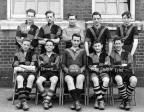 |
The 1943/44 School First XI
This
image was taken in the Tamworth Road school playground.
Top row: Bill Petty,
unknown, Stevens,
unknown, Berty Parsons.
Bottom row: D. Manbridge, Len Brown,
unknown, Peter Oxlade
and Tyler.
|
 |
The 1943/44 School Second XI
This
image was taken in the Tamworth Road school playground - note the
size of those boots as the varied socks (Economy Britain!)
Top row: Gibb, Dunbar,
unknown, unknown,
unknown ,
unknown, unknown,
Pilcher.
Bottom row: unknown,
Packham, McLuskey,
Peter Oxlade, Warren
and Prockter, R.
|
 |
The 1945 School Cricket
Team
This
image was taken in the Tamworth Road school playground.
Top row: Charles Smith,
unknown,
unknown,
unknown,
unknown,
unknown, unknown, unknown, unknown.
Lower: Warren, Brown, unknown, unknown, unknown, unknown,
McLusker, Packham.
|
 |
The 1949/50 School Second XI
This
image was taken in the Tamworth Road school playground.
Top row:
R. Montague, John Amos, Funnell, Banks, Jenkins, Baldwin,
Jackaman.
Bottom row:
Bainbridge, Dean, Sherman, Burnley, Morris.
|
 |
The JRGS 1950 School Soccer
Team
This
image was taken at the Duppas Hill Sports Ground.
From left-to-right: Dean, R. Montague, Amos, Baldwin,
Mackrell, Muggeridge, Burt, Sherman and Childs.
|
 |
The JRGS 1950 School Cricket
Team
This image was taken at the Duppas Hill Sports Ground.
Masters: Charles Smith (left) and Leonard Culcheth
(right).
Top row:
unknown,
Bishop, Arnold,
Duckworth, ,
unknown
and Dubyn.
Bottom row:
unknown, Martin, Alan Montague,
Smith (?) and Stringer.
|
 |
The 1950/1951 League and Cup
winners
Corinthian Shield – Croydon
Schools Trophy
This image was taken at an
unknown location.
Top row: D. Lamb, Fred Evans, Harold Bailey, Johnny Birch and
Melvyn Williams.
Bottom: Fred Drain, Keith Baker, Ray Amos, Laurie Montague, Alan Montague
and Bob Constable. |
|
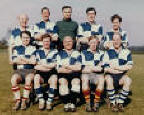 |
The JRGS Master's Football Team
This image was taken at the Oaks Road Sports Ground
in 1959.
Top row: Alan Murray, Sid
Bishop, Arthur Warne, Brian Cook and Anthony
Hasler.
Bottom: J. N. Rhodes,
Neville Graham, Charles Smith, Martin Nunn and
Philip Robertshaw.
|
 |
The JRGS Master's Cricket
Team
The
image was taken at the Oaks Road Sports Ground (date
unknown).
Top row: Kenneth Tryon, Anthony
Hasler, Anthony Field, Philip Robertshaw, Martin Nunn, Dennis Dobson
and
Kenneth Cripps.
Bottom row: Desmond May, Brian
Cooke, John Lowe (Headmaster), Ronald Woodard, Neville Graham
and Charles Smith.
|
|
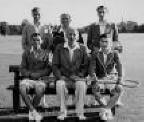 |
The JRGS Master's Tennis Team
This
image was taken at Shirley Sports Club (date
unknown).
Top row: G. M. Evans, Charles
Smith, D. Griffiths.
Bottom row: William Cracknell,
Leonard Chaundy, A. E. C. York. |
|
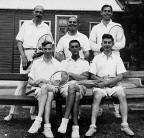 |
The JRGS Master's Tennis Team
This
image was taken at Shirley Sports Club (date
unknown).
Top row:
Leonard
Chaundy, Charles
Smith, George Manning.
Bottom row:
G. M. Evans, William Cracknell,
Alfred York.
|
Cliff Cummins (JRGS
1956-62) adds: As chance would have it, while shopping in Oxted,
Surrey, on Thursday 16th November last year, I met Charles Smith.
Although he still lives in Selsdon with his wife, Elisabeth, he finds
Oxted more accessible - no hills and a shorter walking distance from the
car park to the shops.
Although Charles finds walking more difficult these days, he looked
very well and reminded me that he last saw me at Alan Murray’s Memorial
Service! By the way, he was also keen to tell me: "It’s my birthday
today, I am 94!
He is still a keen water-colour
painter and attends a group three times a week.
Peter Hurn (JRGS 1967-73)
adds:
This is superb.
"Stand up, Mann," he'd say to our cricket captain - Chris Mann
(JRGS 1967-73) - at the Monday lunchtime cricket meeting. Thirty-five
years later, it still sends a shiver down the neck of Mr. Mann!
"You haven't got the guts to get your hair cut," he'd say to one of
our long-haired fraternity in the late Sixties.
Mr. Smith described me as "Lily-livered" when I didn't dive full
length for a catch. I'm still getting over it!
Keep it up!
Terence Morris (JRGS 1942-50)
adds:
How good to see this piece by Charles Smith and his recollections of a
long career.
I was fascinated to know that both he and "Wally" Cracknell taught
at Ingram School, just a stone’s throw from the Beulah, which was my
primary school before going to Ruskin in 1942, the year he joined the
JRCS staff.
"Beulah," I discovered many years later, is the Hebrew for
"Happy
Land”. I loved my time under the Headship of Dan Holman, and my form
master R M King who went on to become Head at Winterbourne, but my first
day in the Infants Department at ‘The Beulah,’ as it was known, had been
a bit like entering a prison. There, I was always it seemed, in trouble!
Any other old "Beulah Boys" around in the JRGS Alumni, I wonder?
I well very well remember "Smithy"’s command of “Up on the wall
bars, boy!” in the old gym at Tamworth Road. Although I was absolute
rubbish at both cricket and football - seeing, essentially, with only my
left eye - he might be interested to learn that out of school I was a
serious cyclist, doing a little grass-track racing but concentrating on
long distance touring.
This, he might be glad to know, I have kept up and although, at
almost 76, I’m a bit slower than I was, I am still looking forward to
the CTC Veterans 100 miles again this year. My time to beat from the
last one is eight hours and 25 minutes. I did the Hampshire stage of the Tour de
France in 1994, the day before the great race, which was organised by the
Cyclists’ Touring Club as a randonee. It ran 113 miles and I "died" on South
Harting Hill – which "Smithy" will know from his youth in Portsmouth. My
time was so bad that I’m embarrassed to admit it in public, but I was by no
means the ‘lanterne rouge’! Your enthusiasm for keeping us fit was a
good investment, Charles. (For the uninitiated, a randonee is a
mass run of individual riders; not a race as such but one in which each
strives to complete the course in the best time he or she can. And
lanterne rouge, like feu rouge, is literally the "red" or
"tail" light - it is the unenviable title given to the last rider to
finish. So now you know.)
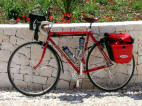 I have many good memories of Charles and his colleagues, especially
"Wally" Cracknell. "Smithy" was a great teacher of RI and got me greatly
interested in the Old Testament, which he managed to turn into a great
adventure story for us to rivet our interest. I also remember one of his
aphorisms, circa 1943: “A man without any kind of belief is like a ship
without a rudder”. Not easily forgotten. I have many good memories of Charles and his colleagues, especially
"Wally" Cracknell. "Smithy" was a great teacher of RI and got me greatly
interested in the Old Testament, which he managed to turn into a great
adventure story for us to rivet our interest. I also remember one of his
aphorisms, circa 1943: “A man without any kind of belief is like a ship
without a rudder”. Not easily forgotten.
He might also be interested to know, if their Alumni Association
haven’t already told him, that his alma mater, King Alfred’s Training
College, is vastly expanded and is now the new University of Winchester.
Shown above
right
is Red Roberts, my favourite touring bike, built bespoke for me by Charles Roberts of
Gloucester Road, Croydon; it is pictured here three years ago by beehive
houses in the mountains of Puglia, in the heel of Italy. This bike has
taken me to the Outer Hebrides, the Apennines, around Cuba and a few
other places. They build 'em good in Croydon! Red Roberts is the name I
give to the bike. I had it painted by Charles Roberts in one of my
favourite colours – Ferrari Red, hence the name.
Harold Fish (JRGS 1951-56)
adds:
Many thanks for this contribution.
Charles Smith was another of my teacher heroes. True, "Smuts" could
be fierce, but I remember him as always fair and ever ready to help
individuals, in my case with early advice on cricket in the nets at
Tamworth Road and on another when I left my new watch at the Waddon
sports grounds. I don't remember all the details but I know I collected
it from his house somewhere on Norwood, if my memory it functioning
properly.
Another bit that struck a chord was the mention of "Wally"
Cracknell and the new school. It was "Wally" who told us that the new
furniture at the school was designed "for fairies" and not clumsy
adolescents like ourselves!
I had forgotten about the uses The Windmill was put to. Of course,
"Smithy" was behind it all as he was no doubt behind the use of the
large green area behind The Windmill for athletics training, the
long-jump pit and, most vividly I remember, for javelin practice.
"Smithy" might remember the last day of the school year 1955-56
when a group of us were able to hang a dummy in school uniform from one
of the windmill sails. Amongst the staff there was a mixture of horror
and curiosity as to how it got there... and how it was to be
taken down!
Anyone who happened to have a camera with them that day had the
film removed and destroyed.
Paul Graham (JRGS 1959-66)
adds:
Reading Mr. Smith's article on his career at John Ruskin and elsewhere
was one of the most heartwarming things to have happened in the six-year
history of this website. It was a privilege to read it, and also to have
met him a year or so ago at Alan Murray's memorial service. I sincerely
hope that I am living life to the full in 35 years time when I reach Mr.
Smith's age, not to mention having such a wicked sense of humour.
I am afraid that I don't even have Terence Morris's excuse for
being so slack at physical activity at JR but, like him, I'm a committed
cyclist, and can still thrash my grown-up children at table tennis
thanks to hours spent at the tables on the Shirley site.
A huge thank you to Peter Oxlade who, with the assistance of our
splendid webmaster Mel Lambert, has spent many hours helping Charles
Smith compile these memories.
 Martin Burch (JRGS 1967-73)
adds:
I stumbled on The Mill website a couple of years back, and have
thoroughly enjoyed it and all the memories it evokes. But the recent
piece by CES is a true highlight. Martin Burch (JRGS 1967-73)
adds:
I stumbled on The Mill website a couple of years back, and have
thoroughly enjoyed it and all the memories it evokes. But the recent
piece by CES is a true highlight.
I cannot imagine that many teachers
have had such a profound effect on so many students.
On the odd occasion when I meet with friends from my years at
Ruskin, "Smut" is invariably one of the first names to come up in our
recollections. To see that he is still going strong at the age of 94 is
wonderful.
I'm sure his teaching style did not suit everyone. But it was
effective with me, not only gaining me an unlikely O-Level but also
instilling in me a numeracy that can put half the accountants I work
with to shame.
Roger Adcock (JRGS 1963-68)
adds:
A remarkable piece - thanks to all involved for making it possible.
But would anyone else in the whole of JRS Alumni - 1941 thru 1978 -
risk taking a photo of the great man at work during a CES class? See
image upper
right
for proof; it shows Minter and Trowell in
Mr. Smith's Maths Class.
Geoffrey C. van Beek
- formerly Downer - (JRGS 1962-69) adds: I found Charles Smith’s
recollections of JRGS extremely fascinating.
I would have made no lasting impression on him whatsoever as I was
useless at anything to do with the displacement of spherical,
air-inflated leather objects such as foot or rugby balls from one patch
of grass to another. Neither was I a natural talent in the numerics
department, but I shall always be grateful for the Mr. Smith’s unique
style of teaching which resulted in my gaining the essential O-Level
Maths needed to study further at university.
The "equals" of every calculation, to be written in blue ink (black
ink was dismissed as the product of a mud stick) all had to be 1 7/8
inches from the right side of the page of our red maths, algebra,
trigonometry and calculus exercise books.
The compulsory addition of accompanying text seemed to bring a
certain order to the whole thing, and give one time to think or for
divine inspiration to descend.: “If, then, thus, therefore, whence, so
that, because, whereupon, notwithstanding….” were typical Classroom
One vocabulary.
The desks were immaculate and I was always terrified of Mr.
Smith, (please note that even now I cannot summon up the courage to
refer to him as "Smudger") especially as I was so slow to grasp the
subject matter, whereas the two genius mathematicians in our class
seemed able to produce correct answers at a frightening rate.
Every two minutes, there they stood at the front of the classroom,
queuing up yet again with what I imagined to be a smirk on their faces
to accept confirmation of their superhuman abilities. It is interesting
to note in the 5G follow-ups that Willsher and McKenny have both become
accountants!
To provide wrong answers could invoke a wrath that was visible from
quite a distance as, comparable with a giant squid on Discovery
Channel, Mr. Smith could change colour from pink to vermillion in
seconds, and go even further to a frightening deep scarlet, and end with
a maximum-alert purple bump on the top of his head.
Mr. Smith - should you read this - please accept my apologies for any
offence taken. None were intended. To get a numerical idiot like me
successfully through O-level Maths is a credit to your teaching
abilities!
Paul Winter
(JRGS 1959-62) adds:
Three memories of Mr. Smith. (I wouldn't dare call him anything else,
just in case he reads this!)
During my brief spell as a teacher at John Ruskin School, we were
chatting in the corridor one day and a queue of first-year pupils
was threatening to become unruly outside a classroom. "Watch this," he
said to me as he strode up to them. They started to get into line. "You,
boy" The unruly one looked up at him. "You - you're ears are
twitching!" at which the unfortunate victim burst into tears! Mr.
Smith then came back to me and said: "That's a lesson for you, Winter.
Make them remember you at an early age!" Even though I taught for 16
years, I never did master that!
In my fifth year, I failed the Maths mock exam. I had never been
very good at Maths and I had certainly not met Mr. Smith in a
classroom teaching situation before. I was about to learn the error of
my ways.
After the results were announced, I went back to my normal
Mathematics class only to find that I and about 20 other "failures" had
been moved to a new class. There was much gossip in the "failure" class
as to what was to happen to us. The consensus was that we would have
some trainee teacher assigned to keep us busy but that our Maths would
remain dire.
How wrong we were! In strode Mr. Smith.
"You are the Mathematics failures, aren't you?" We all agreed
wholeheartedly. "Well you're not - you are all going to PASS."
Most of us did not subscribe to this viewpoint - me included. We
had, however, completely underestimated his sense of dedication and
purpose!
My attitude then was simple. "I can't be bothered with such trivia
as Maths homework!" "Nobody tells me what to in my spare time".
Unfortunately, Mr. Smith was not in agreement with me.
"No homework, eh Winter?" "No, sir" "Well, we will be doing it in
future!" "Yes, sir" (I always did my homework after that.)
Why this change of heart? Well, having your hand up behind your back and your head
banged into the desk did somewhat reinforce his message!
Bless you Mr. Smith. By passing my Maths exam (most of the class
did) I was able to qualify for University entrance, so I will not hear a
word said against the effectiveness of a moderate level of a "positive
approach" in
education!
My third memory of the effectiveness of his educational methods was
being in a "gaggle" of youths being taught the finer points of cricket.
One large and rather lanky lad made an unfortunate remark. Next moment
he was rolling around the ground rather badly winded! "Oh, dear," said
Mr. Smith, helping the lad to his feet, suggesting that he must have
slipped.
It is memories such as this I treasure. Although those days are
long past, Mr. Smith inculcated in me (and probably you) in the absolute
necessity for certain standards of conduct.
ML adds: Our
sincere thanks to Tony Childs
(JRGS 1947-53) for identifying several of the Alumni shown in the
1949-50 School Second XI, JRGS 1950 School Soccer Team and School
Cricket Teams, plus the 1950/1951 Corinthian Shield images. |


